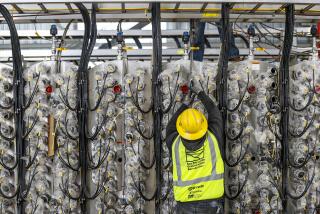DWP Plans to Clean Up Air With Fuel Switch : Environment: Los Angeles agency will use natural gas instead of oil in effort to eliminate 75% of air pollution caused by its four power plants.
The Los Angeles Department of Water and Power announced plans Wednesday to replace fuel oil with cleaner-burning natural gas as part of a $500-million, 10-year program to eliminate 75% of air pollution caused by its four power plants in greater Los Angeles.
At a press conference in Sun Valley attended by Mayor Tom Bradley and South Coast Air Quality Management District Executive Officer James Lents, DWP officials said they have contracted for new gas supplies from Wyoming and Arizona, which will allow them to eliminate oil burning by 1992.
The move “demonstrates the commitment that the department and our city have made” to cleaner air, Bradley said.
The city power plants--including the Valley Generating Station where the briefing was held--already rely mainly on natural gas. But they must routinely switch to oil at times of high gas use by residential and small business customers, who lack the ability to switch fuels.
The DWP signed contracts with two pipeline companies to assure itself steady supplies of up to 250 million cubic feet of gas per day. The contracts will also help the companies finance construction of two pipelines that are to begin delivering gas to Southern California next year.
Although the effect on pollution levels in the region will be very slight, curtailing use of oil is expected to cut nitrogen oxide emissions from the four plants by an estimated 781 tons per year, and sulfur oxide emissions about 1,900 tons per year, according to the air quality management district.
Nitrogen oxides are a lung irritant and contribute to formation of ozone, the main component of smog. Sulfur oxides contribute to fine particulate pollution, a breathing hazard that also reduces visibility.
The DWP and four other local utilities are required by air district regulations to sharply reduce nitrogen oxide emissions over the next 10 years. Besides eliminating use of oil, DWP officials said they expect to invest at least $500 million in pollution control at the power plants by 1999, which could boost electric rates about 5%.
But Lents said the DWP’s oil replacement plan goes beyond the district’s rules, which are aimed only at reducing nitrogen oxides. Burning gas will also cut sulfur oxide emissions, he said.
“It’s a good move on their part,” Lents said.
Lents also acknowledged that the plan will do little to clean up the air. Electric power plants in the four-county air district contribute about 4.3% of nitrogen oxide emissions, most of which come from cars and other vehicles. The four DWP plants are responsible for a little less than one-quarter of the power plant emissions and less than 1% of the total nitrogen oxide pollution in the district.
“This is a small step. Every step forward . . . is a small step,” he said. “There are no big magic pills out there.”
Eldon A. Cotton, the DWP’s assistant general manager for power, said the department has already reduced local power plant emissions 90% in the last 20 years, largely by reducing use of oil and shifting power production out of the area.
He said the 75% reduction in emissions by 1999 will be achieved despite increased power production from the local plants.
The DWP obtains most of its power supplies from coal-fired plants in Arizona, Utah and Nevada and hydroelectric plants in the Pacific Northwest. The four local plants provide 15% to 25% of the city’s total power. Besides the Valley plant, the generating stations are the Haynes plant in Long Beach, the Scattergood plant in Playa del Rey and the Harbor plant in Wilmington.
Last year Bradley reorganized the DWP’s board of commissioners, saying the agency should be more attuned to environmental concerns.
Cotton said DWP officials invited Bradley and Lents to the press conference “to add credibility to what we’re doing, because it’s a big deal.”
More to Read
Sign up for Essential California
The most important California stories and recommendations in your inbox every morning.
You may occasionally receive promotional content from the Los Angeles Times.










